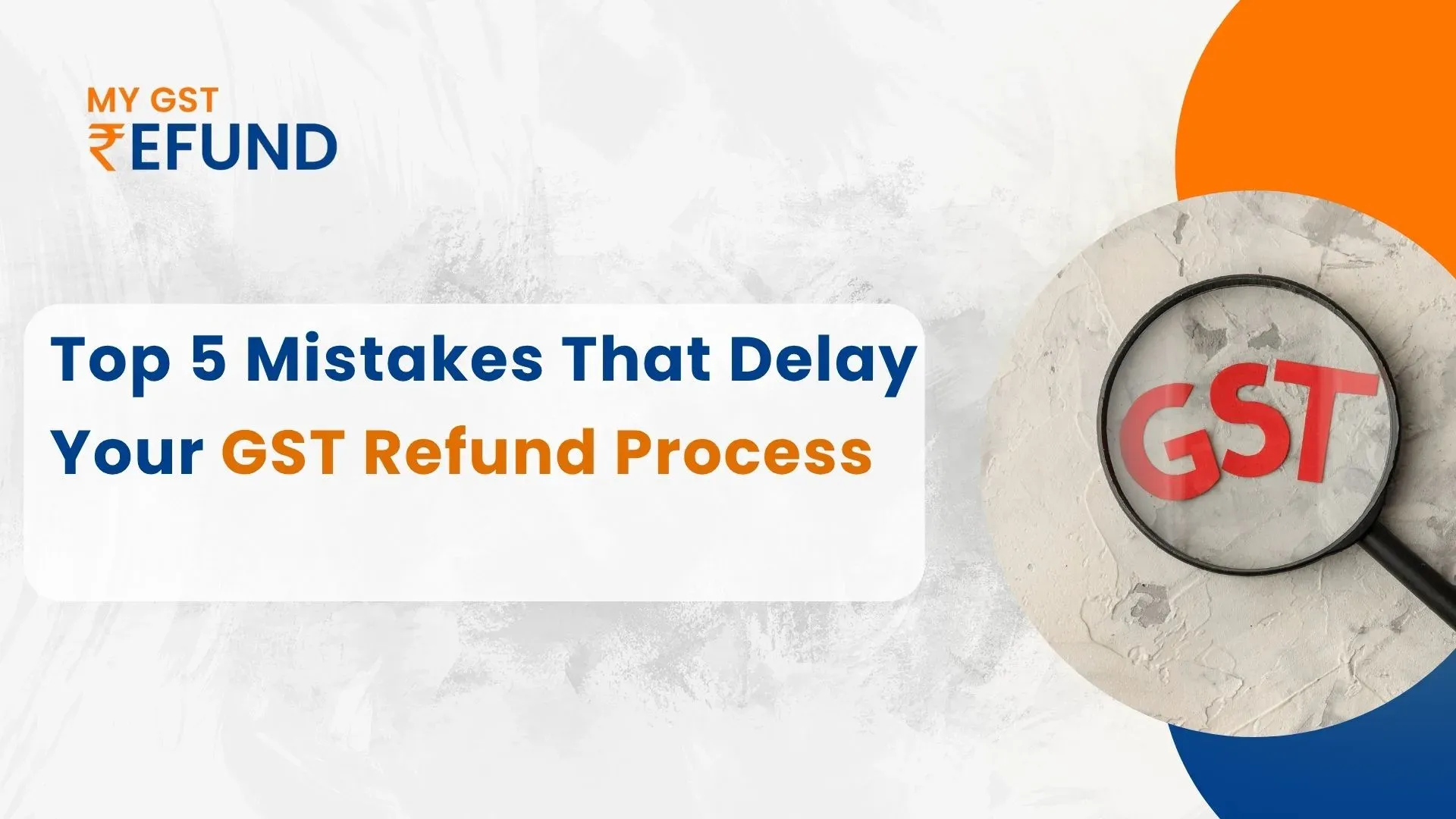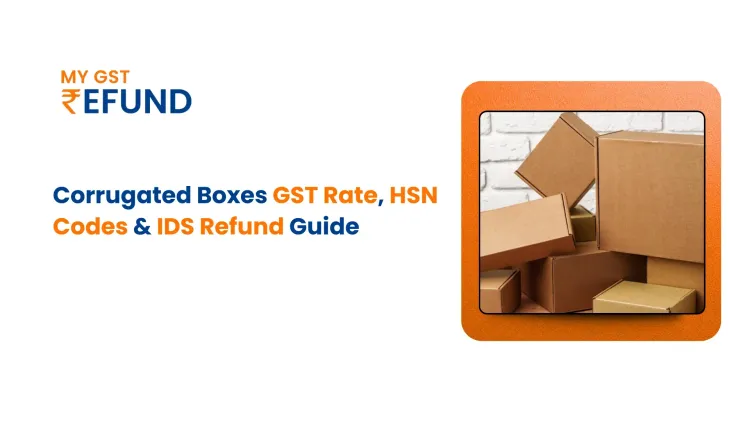Top 5 Mistakes That Delay Your GST Refund!
This guide shows the 5 common GST refund delay mistakes and what you can do to avoid GST refund delays. And, you will also get to know how the MyGSTRefund tool can make your work more efficient, auto-validate entries, and save a tremendous amount of time on refunds. Why Do GST Refunds Get Delayed?
Refunds of zero-rated supply in case of exporters and SEZ units are meant to be smooth- however, more often than not, GST refund delay mistakes are common occurrences because of:
- Incorrect documentation
- Mismatches in returns GSTR-1, GSTR-3B and GSTR-2B
- Block/Unallowed ITC claims
- Missed timelines
- Failure to follow up
These GST refund processing errors can lead to rejections or long processing times.
1. Incomplete Documentation or Inaccurate Documentation
Lost Export Invoices and Shipping Bills
One of the most common GST refund mistakes that exporters encounter is the missing or mismatched export invoices and shipping bills. Such documents should be in harmony with those entries in your GST returns and the ICEGATE portal.
Invoice and Shipping Bill Details Do Not Match.
Invoice and shipping bill data discrepancies, such as a mismatch in invoice numbers or wrong port codes, result in errors in processing the GST refund and rejection of the refund claim.
2. Inconsistency in GSTR 1, GSTR 3B and GSTR 2B
Reconciliation issues GSTR‑1 versus GSTR‑3B
It is important to reconcile GSTR‑1 with GSTR-3B. GSTR‑1 specifies the outward supplies, and GSTR‑3B is a summary of tax liability. This is one of the GST refund delay mistakes that might attract show-cause notices and refund rejections due to a mismatch.
Unfriendly ITC in GSTR‑2B
In case of discrepancy between the Input Tax Credit (ITC) claimed and the auto-populated GSTR‑2B, your application can be flagged. This is among the widely spread GST refund rejection reasons in India.
3. Filing Beyond the Time Limit
- Two-Year Time-Bar on Refund Claims
- An application to get a refund is to be made within 2 years of the concerned date. Failure to meet this deadline renders your claim time-barred expensive and irreversible mistake, delaying GST refund.
4. Claiming Ineligible Input Tax Credit (ITC)
ITC on Capital Goods & Exempt/Domestic Supplies
Exporters usually make claims of ineligible input tax credits in their refund claims. ITC should only be claimed on goods and services utilized in making zero-rated exports. The credits that pertain to capital goods or domestic supplies are not refundable and lead to GST refund processing errors.
With Blocked Credits and RCM Entries:
Input tax credit with respect to blocked categories, such as motor vehicles or Reverse Charge Mechanism (RCM) invoices, cannot be refunded. Incorporating them leads to unwarranted delays and questioning.
5. Deficiency of Follow-up and Rectification Process.
By-passing Deficiency Memos (RFD‑03)
In case of a short application for refund, the tax officer issues a Deficiency Memo (RFD‑03). No action on this memo within the stipulated time leads to rejection or closure. Memo ignorance is one of the severe yet preventable GST refund delay mistakes.
No Follow-Up or Services:
Most of the businesses just sit back and assume that their work is complete after the refund has been filed. Failure to make follow-ups, status checks, and respond to notices is a key factor that causes refunds to remain pending.
Additional Pitfalls That Stall Refunds
Wrong Type or Category of Refund Selected
Missselection of the refund category, e.g., by checking “with payment of tax” instead of “without payment” in LUT, causes errors in processing. Refunds are rejected when the type of refund does not correspond to your export mechanism.
Exports Foreign Exchange & LUT/Bond Mismatches
In the case of export, where no payment of IGST is made, the delay in filing LUT (Letter of Undertaking) or bond on time, or where the LUT numbers in the returns do not match, leads to unnecessary delay in GST refund.
How to Avoid These Mistakes—Best Practices
Reconcile Returns Often
Regularly match GSTR-1, GSTR-3B, and GSTR-2A using reconciliation tools. By doing this, errors are automatically flagged before filing and mismatches are avoided.
Keep thorough export documentation.
Maintain an electronic record of all invoices, shipping bills, LUT/bond filings, and remittance certificates. Many GST refund rejection reasons in India are eliminated with proper documentation.
Reminders & Follow-Up for the Flag Timeline Frequently
- Set automated reminders to ensure you never miss deadlines. Proactively check refund status on the GST portal and respond to updates or memos.
- Double-check ITC Eligibility and Exclude Ineligible Credits.
- Review the type of input tax credit claimed in your refund. Remove credits related to capital goods, blocked services, or RCM entries to avoid GST refund delays.
Quickly Address Deficiency Notices
Responding to RFD-03 memos right away by revising and resubmitting your application with the necessary changes may help avoid longer refund delays.
How does MyGSTRefund assist in resolving these issues?
A specialized tool called the MyGSTRefund calculator was created to address the issues that lead to refund delays. Intelligent automation, compliance alerts, and guided filing workflows are advantageous for exporters and GST-registered companies.
MyGSTRefund helps you in the following ways:
- Auto-validates refund application data for missing or inconsistent entries
- Flags mismatches in GSTR‑1 and GSTR‑3B and helps reconcile them
- Matches ITC claimed with GSTR‑2B to avoid rejection
- Highlights ineligible ITC such as blocked credits, capital goods, and RCM-based entries
- Tracks refund timelines and sends alerts before filing deadlines
- Guides response to deficiency memos (RFD-03) with step-by-step correction
- Reduces manual errors through automated document management and checklist systems
- Provides proactive refund insights based on transaction-level data
With MyGSTRefund, you get a faster, simpler, and error-free refund process, helping you avoid the most common GST refund delay mistakes.
Estimate Your Refund Instantly
Don’t wait for weeks to find out your refund eligibility. Try the GST Refund Calculator by MyGSTRefund to:
- Get instant refund estimates
- Identify errors in return filings
- Know your refund status instantly
- Access a full checklist to avoid rejections
Click here to get started: GST Refund Calculator
Frequently Asked Questions (FAQs)
What happens if I miss the two-year window?
After the two years, refunds cannot be requested. It is crucial to file on time.
After receiving a deficiency memo (RFD-03), is it possible for me to submit again??
Indeed. You must correct the errors mentioned and file a fresh application referencing the old ARN.
How long does it take to get the refund after full compliance?
Typically 15–30 working days, depending on the jurisdiction and accuracy of the refiled documents.
Related Posts







